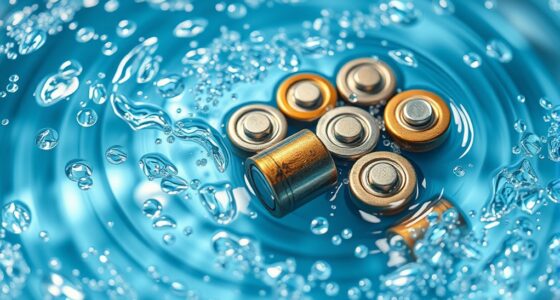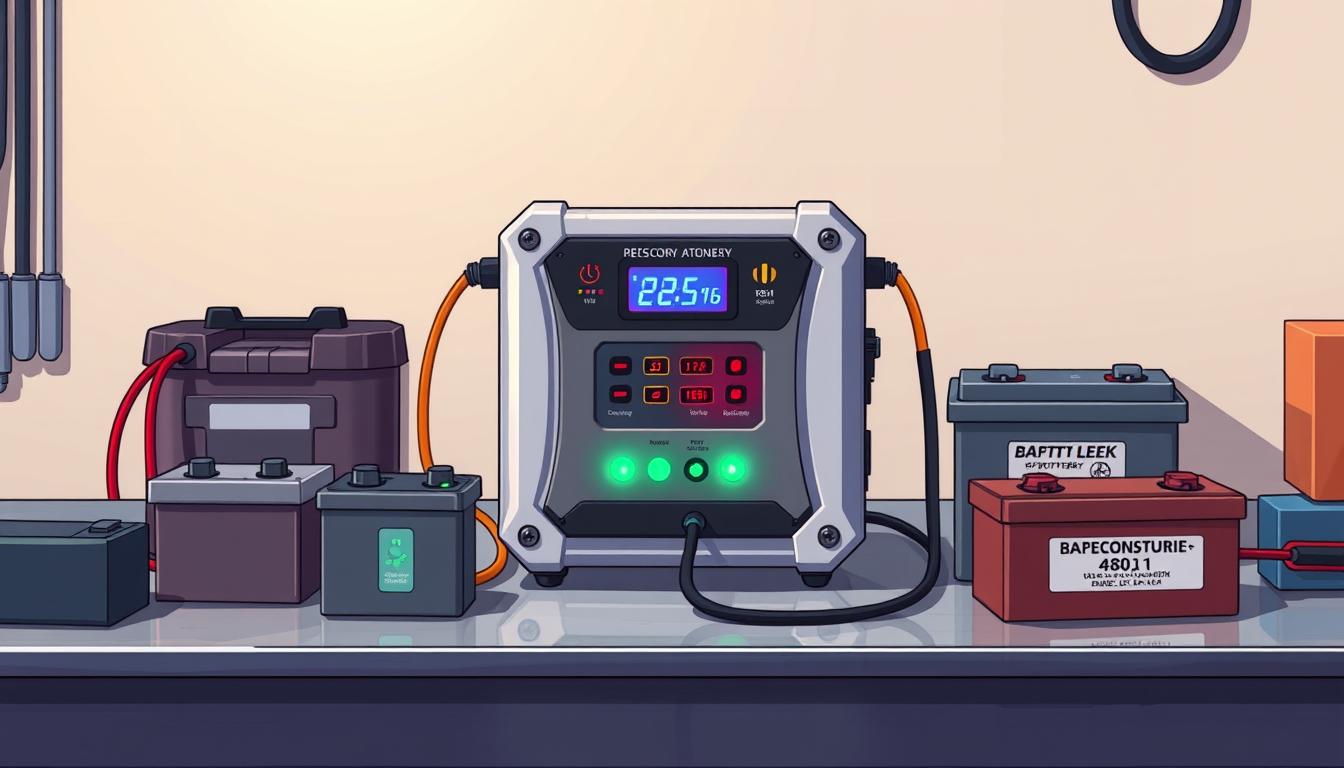Battery reconditioning and deep cycling serve different purposes but both aim to improve your battery’s performance. Reconditioning restores capacity by reversing chemical degradation, helping extend its lifespan. Deep cycling involves fully discharging and recharging the battery to assess or maintain its true capacity. Reconditioning is ideal for worn-out batteries, while deep cycling is useful for calibration and performance optimization. Keep exploring to discover how these techniques can benefit your batteries and save you money.
Key Takeaways
- Battery reconditioning restores degraded chemical processes to extend lifespan, mainly in lead-acid and older lithium-ion batteries.
- Deep cycling involves fully discharging and recharging batteries to assess and maintain their maximum capacity.
- Reconditioning targets chemical restoration, while deep cycling primarily conditions and calibrates battery performance.
- Reconditioning can rejuvenate aged batteries, reducing replacement costs; deep cycling ensures optimal operation and capacity tracking.
- Both techniques, when properly applied, improve battery longevity and efficiency, but serve different maintenance and restoration purposes.

When it comes to extending your battery’s lifespan, understanding the differences between reconditioning and deep cycling is essential. Both methods aim to improve your battery’s performance, but they do so in distinct ways that impact overall battery health and charging efficiency. Reconditioning involves restoring a battery’s capacity by reversing chemical degradation, often through controlled charging and discharging cycles or applying specific treatments. This process can greatly increase the battery’s lifespan, making it function like new again. It’s especially useful for lead-acid batteries or older lithium-ion packs that have lost some of their initial capacity. Reconditioning improves charging efficiency because the battery can accept and hold a charge more effectively, reducing the need for frequent replacements and saving you money in the long run.
Reconditioning restores battery capacity, extends lifespan, and enhances charging efficiency by reversing chemical degradation.
Deep cycling, on the other hand, refers to fully discharging a battery before recharging it to its maximum capacity. This practice is common in applications like electric vehicles or solar energy storage, where batteries are regularly used at or near their full capacity. Deep cycling helps you understand your battery’s true capacity and prevents shallow, inefficient charges that can harm the battery over time. However, it can also accelerate wear if not managed carefully, especially if the battery isn’t designed for frequent deep discharges. When done properly, deep cycling ensures that your battery operates efficiently at its full potential, which can improve charging efficiency because the battery is regularly conditioned to perform at its best through complete charge-discharge cycles.
Both techniques influence your battery’s overall health but serve different purposes. Reconditioning is more about repairing and revitalizing an aging or degraded battery, effectively rejuvenating its chemistry to extend its useful life. It’s a proactive way to maintain or even improve battery capacity and charging efficiency without needing to replace the battery. Deep cycling, meanwhile, is often used to calibrate or condition a new or existing battery, ensuring it’s operating at peak performance. It can help you better understand its capacity and optimize charging routines. Additionally, utilizing portable power sources like power banks for camping can benefit from proper deep cycling and reconditioning practices to prolong their usability.
Ultimately, the choice between reconditioning and deep cycling depends on your specific needs. If your goal is to restore an old or worn-out battery, reconditioning is the way to go. If you want to ensure your battery maintains its maximum capacity and performs reliably over time, incorporating deep cycling into your routine can be beneficial. Both techniques, when applied correctly, can enhance your battery’s lifespan and improve charging efficiency, keeping your devices or systems running smoothly for longer periods.
Frequently Asked Questions
How Does Battery Lifespan Vary Between Reconditioning and Deep Cycling?
You’ll notice that battery longevity often depends on your chosen maintenance strategies. Reconditioning can extend your battery’s life by restoring its capacity, reducing the need for replacement. Deep cycling, on the other hand, may shorten lifespan if done excessively, as it stresses the battery. To maximize longevity, balance deep cycling with regular reconditioning, ensuring your battery stays healthy longer and delivers the best performance over time.
Are There Safety Risks Associated With Deep Cycling Batteries?
Yes, deep cycling batteries can pose safety risks if you don’t follow proper safety precautions. You should conduct a thorough risk assessment before starting, ensuring you handle batteries carefully to avoid leaks or explosions. Use protective gear, work in a well-ventilated area, and monitor the process closely. Taking these precautions minimizes hazards, making deep cycling safer and reducing the chance of accidents or damage.
Can Both Methods Be Used on All Types of Batteries?
Like a master key unlocking potential, you wonder if both methods fit all batteries. Not quite—you need to contemplate battery chemistry, as some types, like lithium-ion, respond differently than lead-acid ones. Recycling methods vary, and applying deep cycling or reconditioning without understanding these differences can damage batteries or reduce efficiency. Always check manufacturer guidelines, as not all batteries tolerate these processes equally, ensuring safe and effective use.
What Are the Cost Differences Between Reconditioning and Deep Cycling?
The cost comparison shows that battery reconditioning usually costs less than deep cycling because it requires fewer resources and less time. Reconditioning can extend your battery’s life at a fraction of the price of replacing it, offering significant economic benefits. Deep cycling, while effective for certain applications, often involves higher costs due to increased energy use and equipment wear. So, if saving money is your goal, reconditioning is typically the smarter choice.
How Do Environmental Impacts Compare for Each Method?
Many believe deep cycling is more eco-friendly, but reconditioning often outperforms it in recycling efficiency and material sustainability. Reconditioning extends battery life, reducing waste and the need for new resource extraction, consequently lowering environmental impact. Deep cycling, however, can accelerate battery degradation, leading to more frequent replacements and waste. Overall, reconditioning supports a more sustainable approach by maximizing resource use and minimizing environmental harm.
Conclusion
Just like the phoenix rising from ashes, choosing between reconditioning and deep cycling can breathe new life into your batteries. Whether you revive an old friend or push your current one to its limits, understanding these techniques empowers you to extend their life and save money. Remember, every battery has a story—your choice can turn that story from end to beginning, giving you hope and power anew. Embrace these methods and let your batteries come back stronger than ever.









